
Carbon – Friend or Foe?

By: Andrea Phan - Outreach Associate
May 23, 2022
Teddy Roosevelt once said, “What we do will affect not only the present but future generations.” This profound declaration carries tremendous weight when we think about today’s farming methods. According to the Brundtland Report of 1987, sustainability was defined as “Development that meets the needs of the present without compromising the ability of future generations to meet their own needs” (Our Common Future, 1987). Do you agree with this definition, and are we living it out? Does it challenge you to consider if we are stewarding our land; and feeding our hungry the nutrition they deserve? Our carrying capacity of natural systems to be protected is crucial; because humans are completely dependent on the goods and services of nature for survival (The Ethics of Sustainability, chapter 1). In thinking about regenerative agriculture, can carbon be our friend?
What is Regenerative Agriculture? It is a practical method of restoring degraded land. There is zero tillage and little to no pesticides or synthetic fertilizers. The purpose is to “continually improve and regenerate the health of the soil by restoring its carbon content, which in return improves plant health, nutrition, and productivity” (Hawken, 54). Do you remember learning about photosynthesis in 5th grade? It turns out that it is the single most effective tool for capturing CO2. So how does regenerative agriculture capture CO2 and address global warming? When converted to sugar in partnership with the sun, CO2 produces plants and food. “It feeds humankind, and through regenerative agriculture, it feeds the life of our soil” (Hawken, 54). Regenerative Agricultural practices increase the organic nutrients in our soil biota. The texture becomes dark and rich full of life-giving nutrients. Water retention is dramatically increased, and trillions of organisms come to life!
If agriculture is responsible for ¼ of our carbon emissions, why not harness the power of this carbon to grow our food? In today’s methods of conventional farming, we are utilizing photosynthesis, but we are not making carbon capture a priority. The constant plowing, tilling, and use of pesticides are releasing that carbon back into the atmosphere. Did you know that ⅓ of our original American topsoil is gone? Our crop yields have never been higher but at the expense of our soil. GMOs, high-yield seeds, nitrogen fertilizers, biocides, and tilling are not the answer. We are now faced with “950 million to 1.1 billion acres of deserted farmland around the world…90% of this happened in the last century” (Hawken, 41). Wasted land means wasted food potential to feed people.
“The world cannot be fed unless the soil is fed” and feeding our soil means less carbon in our atmosphere (Hawken, 55). This is a gift! An invitation for farmers to bring life back to our soil productively, and effectively all through the power of our natural systems. Native vegetation and crop diversity will flourish if we are patient and proactive in our goal to bring back our healthy soil ecosystem. We can turn tragedy into hope, sustaining our future food systems by improving food security, creating jobs for farmers, and sequestering our carbon back into the soil where it belongs.


